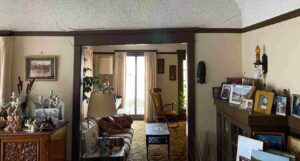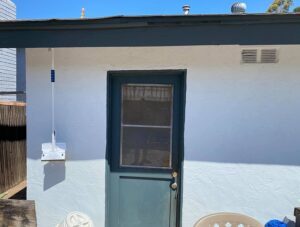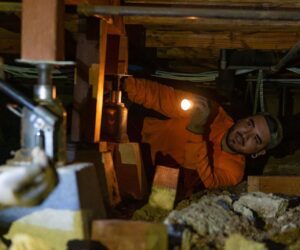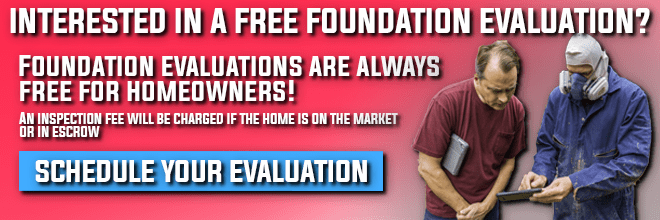After meeting with numerous foundation repair companies, you have come to the understanding that your home has foundation settlement issues.
You have read countless articles to better educate yourself on the foundation repair process in order to make the best decision for you and your family.
But now the foundation repair contractor has asked if you are interested in lifting your home or if you simply want to stabilize it in place.
This article will cover what to expect if you choose to lift your home’s foundation during your foundation repair project in terms of:
- Damages
- Corrections
- Costs
- Warranty Impacts

Damages
Damages associated with lifting your home tend to be cosmetic (cracked drywall/tile/stucco) rather than posing serious threats to the structural integrity of your domicile.
One of the most common cosmetic corruptions that we see when lifting a home is additional drywall cracking.
The cracking typically occurs in any area that has undergone a recent remodel or repair.
If drywall has recently been patched with spackle and repainted, the filler will be exerted out when the home is re-leveled (forcing the original fractured sheetrock back together).
Never invest in a sheetrock repair project or serious home remodel if you’re not absolutely certain your home has no foundation issues.
If you repair drywall without addressing the real root of the issue, you will have to repair it again as your home continues to settle further into expansive soil.
It will be an endless patch-and-paint cycle.
These “repairs” just mask the foundation problem. Granted, it is much easier to patch drywall cracks than to fix a home’s foundation, but the cosmetic fix will be short-lived.
The same can be said for stucco cracks. Typically, you will see similar cracks in your stucco that you see in your drywall – often fracturing out from door and window frames.
Doors and windows can also be compromised. They often get stuck and jam in frames torqued crooked by the settling, uneven load of the house.
Doors are often shaved down, and windows retrofitted to appear to be “level” with the home.
A good professional door and window company, more often than not, will not install doors or windows out of square.
Instead, they adjust the framing around the doors and windows to give the illusion that your home is level.
Just like with drywall and stucco, any temporary repairs or adjustments made on doors and windows will be negatively impacted during the foundation repair project.
Shortcuts will come back and bite you in the gypsum board when it comes to foundation repair.
One final note, cracks may also lightning out from your foundation or slab. These are not common; however, they can still occur.
More often than not, cracks are already present, and the foundation lift simply accentuates them.

Corrections
Alright, how that we have the hard stuff out of the way, on to the good news. The good news is, just like various factors can get damaged during a lift, many corrections occur.
For example, with the cracked drywall and stucco, this is one area of life where procrastination pays off!
The cracks in your sheetrock and stucco are like a door hinge. When a door is opened, the gap expands. When the door closes, the gap decreases or becomes non-existent. This same principle can also apply to stucco and gypsum board.
The cracks close up once the home is lifted. And, occasionally, they close up so well they are almost non-existent.
Granted, you will still be able to see where the cracks were, but now they simply hairline cracks and easily repaired after a successful lift.
Doors and windows – exact same story, exact same outcome. They are returned to level and brought back to 100% functionality (if they have not been modified prior to the home settling).
The curse has been lifted. The spell has been broken. We have seen customers open doors and windows they hadn’t been able to open for years or even decades.
These homeowners were ecstatic to have functional doors and windows again.
Cost
Turns out, there are a few extra costs that can occur when lifting your home’s foundation. The first thing to take into consideration is the cost associated with cosmetic repairs.
It is imperative to factor in the cost of possible cosmetic damage that can occur during a lift. Recall everything we covered in the damages section – yeah, those.
The damaged sheetrock, stucco, doors, and windows will generate some costs, but you know what? It should be the last time that they will ever need to be repaired!
Once the home has been lifted to maximum practical recovery, the cracks can be repaired once and for all.
Of course, you can still have some cracking in your home after the lift. This typically occurs if you go through extreme droughts or times of extreme humidity.
The reason is that the wood framing that makes up the wooden bones of your home is an organic material. Organic material is impacted by the amount of moisture in the air.
Wet organic materials expand. Dry organic materials shrink. Constant expansion and shrinkage, due to an improperly acclimated home, cause sheetrock fracture.
Drywall patch-and-painting usually costs around $3 to $5 dollars a square foot (depending on the amount of area that needs to be addressed).
Doors and windows will also need to be taken into account. Adjusting doors can run upwards of $200 per door.
Repairing cracks in the slab or foundation is another potential expense. The good news, the relatively reassuring news, is that these cracks are not just superficial because you have corrected the “cause” of the cracking in the first place.
These cracks need to be repaired so that moisture isn’t able to penetrate and soak up into the rebar buried inside. Wet rebar rusts, expands, and can break off chunks of your footing.
Repairing foundation cracks ranges from $100 per linear foot to $200 per linear foot – depending on the size of the crack and the repair technique required.
The final cost to take into consideration is the expenditure of the void fill material (polyurethane) that goes beneath your home’s slab or the cost to adjust posts and pads if you have a raised foundation.
This is an absolute must, to add the proper support to the interior of your home.
It doesn’t make sense to lift your home’s foundation and then leave the slab/subfloor unsupported to leave yourself open to additional problems down the road.
The cost of adjusting posts and performing a void fill ranges from $5 to $10 dollars per linear foot. This area is typically limited to the area where the foundation repairs and lift occur.
If you would like a more detailed, comprehensive overview of the costs of foundation repair, you should read our blog on foundation repair costs.

Warranty
This one is simple – there is no adjustment to the warranty whether we lift your home or not. The standard warranties in the foundation repair industry range anywhere from 10 to 75 years.
Lifting the home has absolutely no impact on the warranty of the material that is utilized or the corresponding workmanship.
Here at Dalinghaus Construction Inc., where we are proud to serve Southern California and Central Arizona, we offer a lifetime warranty on all of our steel pier systems.
Dalinghaus Provides Foundation Repair Solutions
Well, there you have it, ladies and gentlemen. You are not aware of the most common line items that occur during a foundation repair project.
Obviously, you should lift your home if the pros outweigh the cons – which they do.
Dalinghaus always recommends lifting and leveling the home unless you have other underlying issues.
If you reside in sunny Southern California or in the beautiful, red-rocked Central Arizona area, click on the link below for a FREE foundation inspection –







